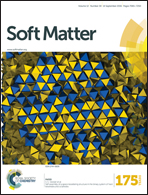Hydrogen bonding asymmetric star-shape derivative of bile acid leads to supramolecular fibrillar aggregates that wrap into micrometer spheres†
Abstract
We report that star-shaped molecules with cholic acid cores asymmetrically grafted by low molecular weight polymers with hydrogen bonding end-groups undergo aggregation to nanofibers, which subsequently wrap into micrometer spherical aggregates with low density cores. Therein the facially amphiphilic cholic acid (CA) is functionalized by four flexible allyl glycidyl ether (AGE) side chains, which are terminated with hydrogen bonding 2-ureido-4[1H]pyrimidinone (UPy) end-groups as connected by hexyl spacers, denoted as CA(AGE6-C6H12-UPy)4. This wedge-shaped molecule is expected to allow the formation of a rich variety of solvent-dependent structures due to the complex interplay of interactions, enabled by its polar/nonpolar surface-active structure, the hydrophobicity of the CA in aqueous medium, and the possibility to control hydrogen bonding between UPy molecules by solvent selection. In DMSO, the surfactant-like CA(AGE6-C6H12-UPy)4 self-assembles into nanometer scale micelles, as expected due to its nonpolar CA apexes, solubilized AGE6-C6H12-UPy chains, and suppressed mutual hydrogen bonds between the UPys. Dialysis in water leads to nanofibers with lateral dimensions of 20–50 nm. This is explained by promoted aggregation as the hydrogen bonds between UPy molecules start to become activated, the reduced solvent dispersibility of the AGE-chains, and the hydrophobicity of CA. Finally, in pure water the nanofibers wrap into micrometer spheres having low density cores. In this case, strong complementary hydrogen bonds between UPy molecules of different molecules can form, thus promoting lateral interactions between the nanofibers, as allowed by the hydrophobic hexyl spacers. The wrapping is illustrated by transmission electron microscopy tomographic 3D reconstructions. More generally, we foresee hierarchically structured matter bridging the length scales from molecular to micrometer scale by sequentially triggering supramolecular interactions.



 Please wait while we load your content...
Please wait while we load your content...